
A whole house humidifier can make a big difference in your health and the overall comfort in your home. After all, it’s not just temperature of the air that affects your comfort level – humidity plays a big part, too.
When your furnace or fireplace runs it dries out the air in your home, making you more uncomfortable than you may realize. You may get a stuffy feeling and perhaps a raspy throat, or your lips get chapped, but it may not occur to you that overly dry air the problem.
Dry air usually is worst during the coldest months of the year, when the chilly air that seeps into your home is typically much drier than during warmer months. Heating it with your furnace dries it out even more.
Air Conditioners Remove Humidity – and So Do Furnaces
On hot summer days your central air conditioning will pull excess humidity from the air to make you more comfortable. Unfortunately, while your heating system can add warmth to your home in the winter, it can’t add humidity.
That’s where a humidifier added to your central HVAC system can help. But as you decide whether humidifying the whole house is the right solution for you, first consider how these humidifiers work. Weigh the benefits and potential drawbacks and decide whether there are other products that may work better for you.
What is a Whole House Humidifier?
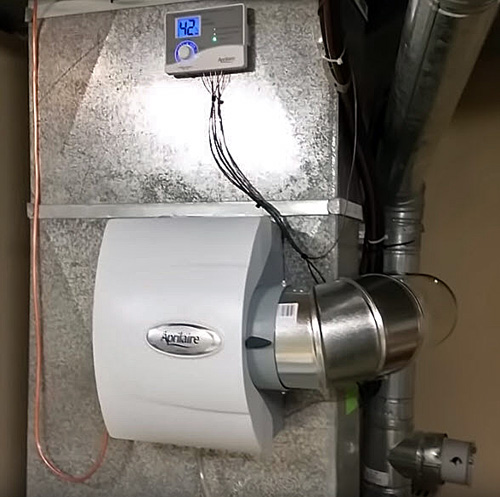 A humidifier that adds humidity throughout your home connects directly to your heating system. There are several types of whole home humidifiers, which we’ll get to later, but they all achieve the same thing: adding water vapor to the air in your home.
A humidifier that adds humidity throughout your home connects directly to your heating system. There are several types of whole home humidifiers, which we’ll get to later, but they all achieve the same thing: adding water vapor to the air in your home.
The whole house humidifier, also called a furnace humidifier, is connected to the home’s duct system. When it’s turned on (most are set to come on automatically), it adds a controlled amount of moisture to the air that is pulled or pushed by a fan into the duct system and distributed throughout the house.
The amount of humidity in the air can be monitored and controlled through a humidistat, a device that measures the moisture in the air.
Signs You May Need a Central Humidifying System
When it comes to the air in a home, whether it’s temperature, humidity or some other aspect, every person has his or her own comfort preferences. So, there’s no “one size fits all” solution to maximizing the comfort level in your home.
There are, however, some common signs that your home’s air might be too dry:
 If you suffer from dry skin or itchy eyes, get nosebleeds or often have a sore or scratchy throat, it could be an indication that the air in your home is too dry.
If you suffer from dry skin or itchy eyes, get nosebleeds or often have a sore or scratchy throat, it could be an indication that the air in your home is too dry.- Dry air in homes increases static electricity, which you can feel in your clothes or when touching furniture or doorknobs after walking across the carpet. Static electricity discharges are generally not harmful to people, but they’re certainly annoying, especially if they’re frequent.
- In an overly dry home, hardwood floors and wood cabinets might contract and warp. Paint on the walls also can crack.
So how humid should the air in your house be?
It goes back to individual preferences, but most people feel comfortable when the relative humidity is between 30 and 50 percent. You can check the humidity levels of your home with a hygrometer, an instrument that measures the amount of humidity in the air. Hygrometers are inexpensive and available at stores and on the internet.
The Types of Whole Home Humidifiers
Now that we’ve looked at the need, let’s talk about what’s available to improve the humidity level in your home. There are three types of whole house humidifiers.
Bypass Humidifiers
 Bypass humidifiers are connected to the air return or air handler of a furnace to add moisture to the air. Bypass humidifiers are connected directly to the furnace’s return air duct. The furnace’s blower motor pushes the air through the water panel in the humidifier, where the air absorbs humidity before it is blown through the heat ducts.
Bypass humidifiers are connected to the air return or air handler of a furnace to add moisture to the air. Bypass humidifiers are connected directly to the furnace’s return air duct. The furnace’s blower motor pushes the air through the water panel in the humidifier, where the air absorbs humidity before it is blown through the heat ducts.
Bypass whole home humidifiers have no moving parts, so maintenance costs are low. But the bypass ductwork requires extra room, which can be a problem in tight spaces. Because the air circulates in a continuous loop through the furnace and ductwork it loses humidity each time around the circuit. Also, most unites have a damper in the bypass ductwork that must be manually opened when cold weather sets in.
Fan-powered Humidifiers
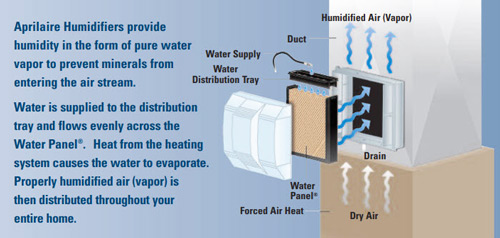 Fan-powered humidifiers are like bypass humidifiers, but they include a fan that blows air across the water panel instead of using diverted air. They require no additional ductwork.
Fan-powered humidifiers are like bypass humidifiers, but they include a fan that blows air across the water panel instead of using diverted air. They require no additional ductwork.
Fan-powered humidifiers are more efficient because they blow moisture directly into the heated air just before it enters the ductwork. This higher efficiency allows them to add as much as a gallon of additional water to the air each day, which makes fan-powered humidifiers well suited for big homes.
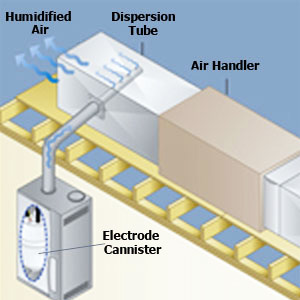 These humidifiers may require a bit more maintenance than bypass humidifiers, but maintenance should not be a big concern if water pads are changed and the equipment is serviced annually.
These humidifiers may require a bit more maintenance than bypass humidifiers, but maintenance should not be a big concern if water pads are changed and the equipment is serviced annually.
Steam Humidifiers
Steam humidifiers add humidity to the air by boiling water. Instead of using a water pad, the steam from the boiled water goes directly into the air just before it enters the ductwork. Steam humidifiers are both the fastest and most efficient of the three types of whole house humidifiers, but they are also the most expensive to buy and most complicated to install and maintain. They also are well-suited to big homes.
The setup of your home’s HVAC system can sometimes determine which type is best to humidify your whole house. An air conditioning professional can provide information on your system to help you make the decision.
What are the Benefits of a Whole House Humidifier?
A humidifier integrated with your HVAC system can help you maintain healthy humidity levels throughout your home. Here are some of the specific benefits you can expect:
Health and comfort: Adding moisture to a dry home can alleviate problems with dry skin, lips and nasal passages previously discussed. But there are bigger health benefits, as well.
Healthy humidity levels can also reduce symptoms of asthma and make you less susceptible to colds. Some really interesting research shows that a humidity level of 40 percent or higher can dramatically increase the effectivity of influenza virus inoculations.
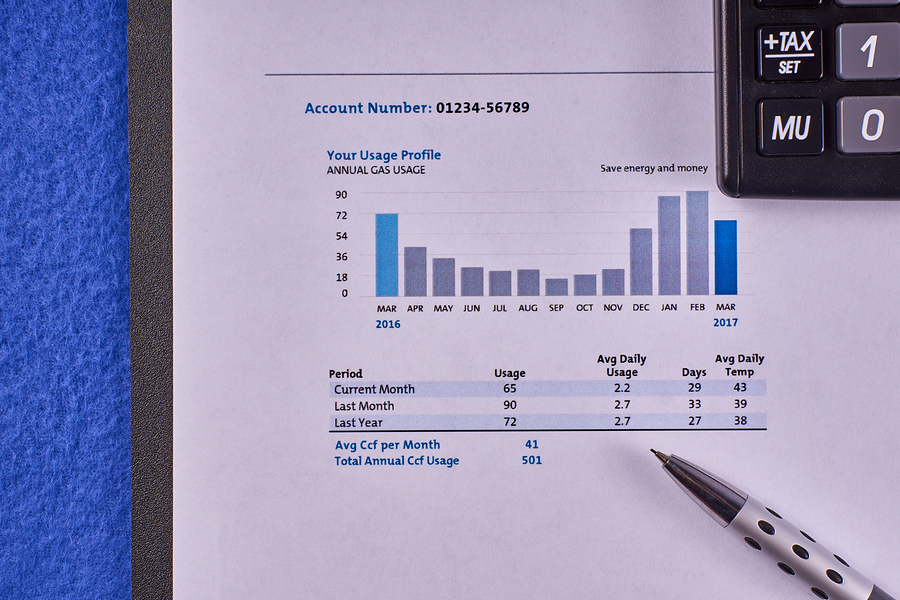 Home protection: Proper humidity levels can prevent hardwood floors and cabinetry from warping and keep paint from cracking and chipping on the walls. Eliminating the overly dry air also helps protect electronic devices from electrostatic discharge, which can cause serious damage.
Home protection: Proper humidity levels can prevent hardwood floors and cabinetry from warping and keep paint from cracking and chipping on the walls. Eliminating the overly dry air also helps protect electronic devices from electrostatic discharge, which can cause serious damage.
Lower utility bills: A home with higher humidity levels feels warmer and can allow the thermostat to be set at a lower temperature during the winter. The Department of Energy estimates homeowners can lower their heating costs by approximately three percent in the winter for each degree that the thermostat is lowered.
Is There a Downside to Humidifying Through Your Furnace?
It’s not good for your home or your health when the air is too dry, but it’s also not good when the air is too moist. (“Everything in moderation” really applies here).
If a whole house humidifier is not monitored correctly and properly maintained, there’s the risk of adding too much moisture to the home. That can lead to problems.
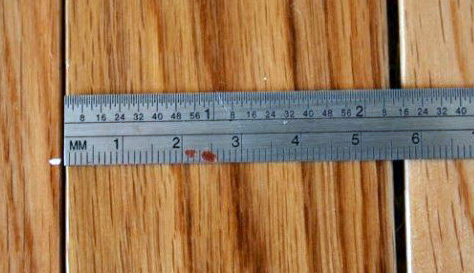 Mold growth: Heavy moisture in the air can condense on walls and windows. That can lead to mold growth, which can cause coughing, sneezing and itchy eyes. Mold can form in the ductwork, and the mold spores can be distributed through the air in your home. People with allergies and respiratory conditions are especially affected.
Mold growth: Heavy moisture in the air can condense on walls and windows. That can lead to mold growth, which can cause coughing, sneezing and itchy eyes. Mold can form in the ductwork, and the mold spores can be distributed through the air in your home. People with allergies and respiratory conditions are especially affected.- Damage to wood: Air that is too dry can cause wood floors and furniture to crack or separate at joints. Air that is too humid can cause swelling and cupping of hardwood floors.
How to Avoid Problems of Whole House Humidification
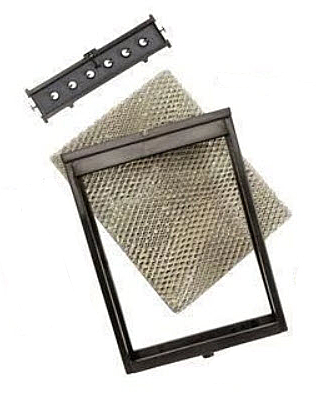 Some HVAC system thermostats monitor humidity levels, but if that’s not the case in your home, you can buy inexpensive humidity monitors to place in rooms. As mentioned earlier, humidity levels between 30 and 50 percent are typically comfortable for most people. (Others prefer humidity levels up to 60 percent).
Some HVAC system thermostats monitor humidity levels, but if that’s not the case in your home, you can buy inexpensive humidity monitors to place in rooms. As mentioned earlier, humidity levels between 30 and 50 percent are typically comfortable for most people. (Others prefer humidity levels up to 60 percent).
Maintenance is essential for whole house humidifiers. The humidifier’s water panel needs to be replaced at least once per year. This image at right shows a water panel, water distribution tray (top) and framework removed from the humidifier for maintenance. The tray attaches to the top of the frame to receive the water feed and spread it evenly across the top of the water pad.
It’s also important to use quality filters in your HVAC system and clean up spills in the home and fix any water leaks.
No matter what time of year, make sure that your home is getting proper ventilation. According to the EPA, indoor air quality is generally four to five times worse than outdoor air quality. That’s why it’s important to have air flow that can remove the “polluted” indoor air and replace it with air from outside.
What Can I Use Instead of a Whole Home Humidifier?
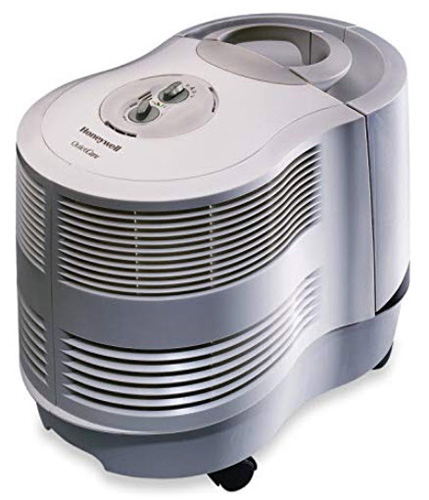
A whole house humidifier can substantially change the humidity level throughout your home. Portable humidifiers (also known as table humidifiers and point-of-use humidifiers) can be effective for humidifying a single room, which is why they are also called single-room humidifiers.
Many people like to use portable humidifiers when sleeping because the moisture in the room is beneficial to hair and skin and can alleviate allergy and asthma symptoms. Additionally, a portable humidifier can help reduce snoring because the moist air prevents tissue in your nose and throat from drying out.
The Downside of Portable Humidifiers
Portable humidifiers can be helpful, but their downside is clear. Although they won’t add humidity throughout the house, they still need considerable maintenance to work properly and be safe for the home – in fact, more than required by whole-house systems.
The water in a portable humidifier needs to be changed daily because standing water can contribute to mold growth, and the humidifier also needs to be cleaned and dried weekly. If it has a filter, that needs to be changed according to the product guidelines.
Why is this so important?
If you don’t take care of the portable humidifier, it can release bacteria and mold into the air. According to the EPA, microorganisms often grow in humidifiers which are equipped with tanks containing standing water, and breathing mist containing these pollutants has been implicated as causing a certain type of inflammation of the lungs.
Other Ways to Add Moisture to Your Home’s Air
Humidifiers are the best way to deal with dry air, but you can increase humidity in your home in other ways, too. During the cold winter months when the air can get extremely dry, some people like to leave bowls of water around their house to increase the moisture in the air.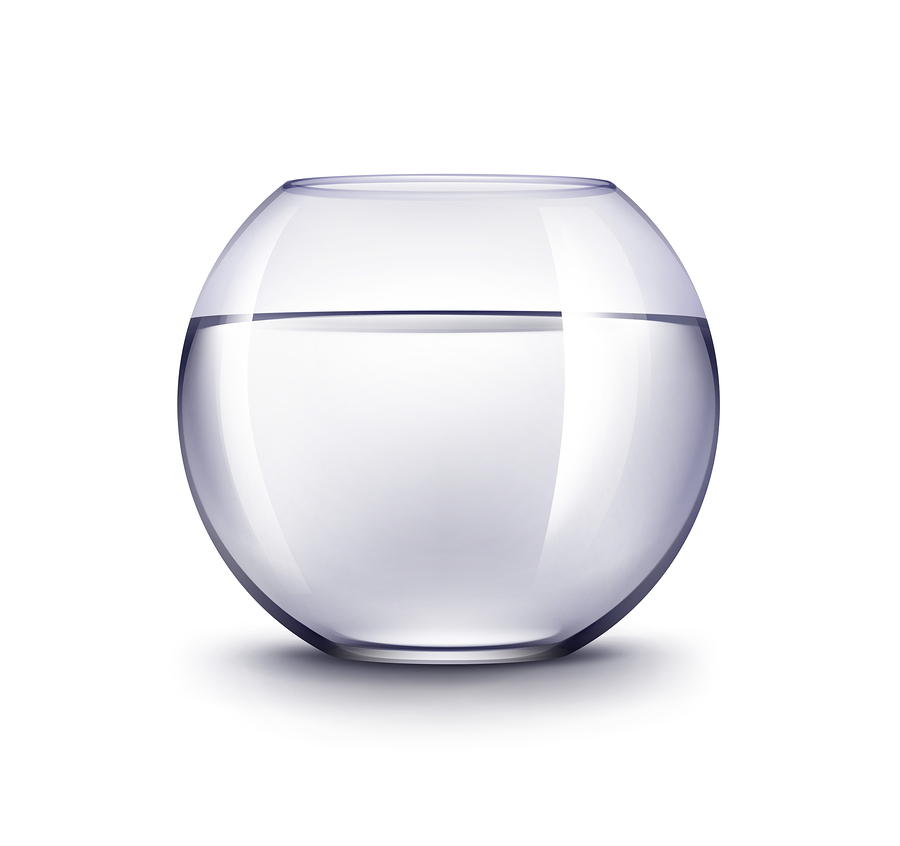
The effectiveness is limited, but it doesn’t hurt. Here are some other ways that you can add moisture to your home’s air:
- When taking a shower, leave the bathroom fan off and crack the bathroom door so the humid air can escape to other parts of the house.
- After taking a bath, don’t drain the water immediately. Allow the water to cool and the evaporation process will help moisten the air.
- Houseplants can add humidity to a room because they release moisture through a process called transpiration.
- When your dishwasher is done with its cycle, open the door and let the dishes air dry. The air coming out is extremely humid and can help offset the dry air.
- Although nobody wants to be cold in the winter, lowering the thermostat a few degrees will reduce the dryness of the air.
Conclusion
Just as temperature control is essential for your home, the moisture level of the air is equally important to your comfort and wellness. A whole house humidifier provides the most efficient and low-maintenance way to put needed moisture in dry winter air.
There are other options, including portable humidifiers and low-tech ideas that might offer some partial or temporary solutions.
If someone in your family suffers from allergies or asthma or is otherwise affected by the dry air, then it’s worth your time to look at the benefits of a fan-powered, bypass or steam whole home humidifier.
Comfort may be your main objective, but there are also great health benefits to having air in the correct humidity range, including less risk of catching colds and viruses.
If you do choose to add a humidifier, consult with a certified HVAC professional. Whole house humidifiers work through the HVAC system, after all, and the HVAC pro can help you determine what type of equipment will be best and provide expert installation.

